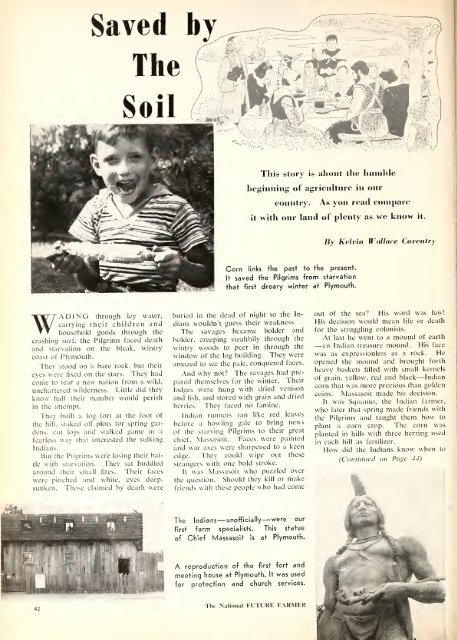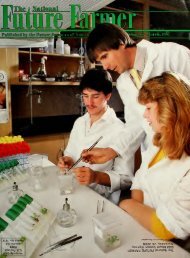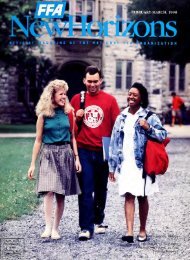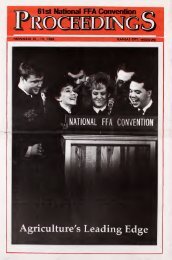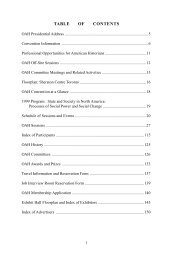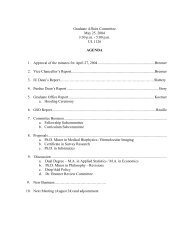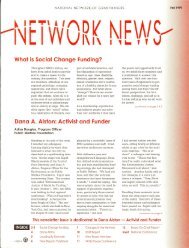Create successful ePaper yourself
Turn your PDF publications into a flip-book with our unique Google optimized e-Paper software.
WADING<br />
Saved<br />
through icy water,<br />
carrying their children and<br />
household goods through the<br />
crashing surf, the Pilgrims faced death<br />
and starvation on the bleak, wintry<br />
coast of Plymouth.<br />
They stood on a bare rock, but their<br />
eyes were fixed on the stars. They had<br />
come to tear a new nation from a wild,<br />
unchartered wilderness. Little did they<br />
know half their number would perish<br />
in the attempt.<br />
They hLiilt a log fort at the foot of<br />
the hill, staked otT plots for spring gar-<br />
dens, cut logs and stalked game in a<br />
fearless way that interested the SLilking<br />
Indians.<br />
But the Pilgrims were losing their battle<br />
with starvation. They sat huddled<br />
around their small fires. Their faces<br />
were pinched and white, eyes deepsunken.<br />
Those claimed by death were<br />
42<br />
.-_L<br />
'^ V. ->, (.-^ )^ ^-<br />
This story is about the huinble<br />
beginning of agriculture in our<br />
country. As you read compare<br />
it with our land of plenty as we know it.<br />
Corn links fhe past to the present.<br />
It saved the Pilgrims from starvation<br />
that first dreary winter at Plymouth.<br />
buried in the dead of night so the Indians<br />
wouldn't guess their weakness.<br />
The savages became bolder and<br />
bolder, creeping stealthily through the<br />
wintry woods to peer in through the<br />
w indow of the log building. They were<br />
amazed to see the pale, conquered faces.<br />
And why not? The savages had prepared<br />
themselves for the winter. Their<br />
lodges were hung with dried venison<br />
and fish, and stored with grain and dried<br />
berries. They faced no famine.<br />
Indian runners ran like red leaves<br />
before a howling gale to bring news<br />
of the starving Pilgrims to their great<br />
chief, Massasoit. Faces were painted<br />
and war axes were sharpened to a keen<br />
edge. They could wipe out these<br />
strangers with one bold stroke.<br />
It v\as Massasoit who puzzled over<br />
the question. Should they kill or make<br />
friends w ith these people who had come<br />
The Indians— unofficially—were our<br />
first farm specialists. This statue<br />
of Chief Massasoit Is at Plymouth.<br />
A reproduction of the first fort and<br />
meeting house at Plymouth. It was used<br />
for protection and church services.<br />
The <strong>National</strong> FUTURE F.\RMER<br />
By Kelvin Wallace Coventry<br />
out of the sea? His word was law!<br />
His decision would mean life or death<br />
for the struggling colonists.<br />
At last he went to a mound of earth<br />
—an Indian treasure mound. His face<br />
was as expressionless as a rock. He<br />
opened the mound and brought forth<br />
heavy baskets filled with small kernels<br />
of grain, yellow, red and black— Indian<br />
corn that was more precious than golden<br />
coins. Massasoit made his decision.<br />
It was .Squanto, the Indian farmer,<br />
who later that spring made friends with<br />
the Pilgrims and taught them how to<br />
plant a corn crop. The corn was<br />
planted in hills with three herring used<br />
in each hill as fertilizer.<br />
How did the Indians know when to<br />
(Continued on Page 44)


